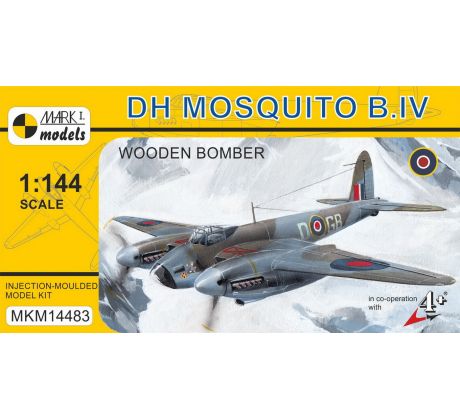de Havilland Mosquito B.IV 'Wooden Bomber'

de Havilland Mosquito B.IV 'Wooden Bomber'
Description: This injection-moulded kit contains 64 parts and eleven clear parts (the cockpit canopy, nose window, wing tips with position lights etc.). A comprehensive decal sheet is included.
Colour schemes included in the kit:
1) de Havilland DH.98 Mosquito B Mk.IV (Srs.II), DZ548, Sky GB-D "Knave of Diamonds", No.105 Sq., Royal Air Force, Marham airfield, June 1943
2) de Havilland DH.98 Mosquito B Mk.IV (Srs.II), DZ515, Sky XD-M, No.139 (Jamaica) Sq., Royal Air Force, Horsham St. Faith airfield, summer 1942
3) de Havilland DH.98 Mosquito B Mk.IV (Srs.II), DZ518, Red AZ-F, No.627 Sq., Royal Air Force, Woodhall Spa airfield, August 1944
4) de Havilland DH.98 Mosquito B Mk.IV (Srs.II), DZ525, Red AZ-S, No.627 Sq., Royal Air Force, Woodhall Spa airfield, 1945
| Ref. No.: | MKM144083 |
| Availability: | IN STOCK |
de Havilland Mosquito B.IV 'Wooden Bomber'
The de Havilland DH.98 Mosquito was a British multi-role combat aircraft developed in 1939. The Mosquito was constructed almost entirely of wood and, as such, it was dubbed "The Wooden Wonder". Originally conceived as an unarmed high-speed bomber, it was later adapted to many other roles, including day-time tactical bomber, night bomber, day or night fighter, fighter-bomber, maritime interceptor and photo-reconnaissance aircraft.
The Mosquito B Mk.IV was a day and night bomber variant, whose prototype first flew in September 1941. Some 300 aircraft were built (incl. Srs.I a/c); Series II model entered service in May 1942. It was a two-seat, twin-engine, mid-wing monoplane, of a composite wood construction, fitted with a retractable undercarriage. The crew was seated under conventional canopy and for bombing a glazed nose was provided. It was powered by two Merlin in-line engines turning narrow three-bladed propellers. Its internal bombload was 2,000 lb (908 kg), while a provision was also made for two 50-gal (227 1itre) underwing drop tanks or two 250lb bombs.
Total war production of all Mosquito models in Britain gave more than 6,700 aircraft. In 1942 production was also launched in Canada in Australia, adding totals of some 1,100 and 210 aircraft, respectively.
The Mosquito flew with the RAF and other air forces in the European and Mediterranean theatres. Later Mark Mosquitoes were also operated by the RAF in the South East Asia and by the Royal Australian Air Force.
Products purchased together with this product
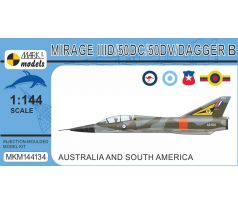
Mirage IIID/50DC/50DV/Dagger B Two-seater ‘Australia & South America’
This injection-moulded kit contains 47 parts and two clear parts (the cockpit canopy and a landing/taxiing lamp). A comprehensive decal sheet is included.
1) AMD/GAF Mirage IIID, s/n A3-104, White 104, No.2 OCU (Operational Conversion Unit), Royal Australian Air Force, Williamtown Base, New South Wales, Australia, 1979
2) IAI Dagger B (ex-IAF Nesher T), C-426 (c/n T-05), Black C-426, Escuadrón I de Cazabombardeo (Fighter-Bomber Sq.), Grupo Aéreo 6 de Caza (Air Fighter Group), VI. Brigada Aérea (Air Brigade), Argentinian Air Force (Fuerza Aérea Argentina), Tandil Military Air Base (BAM), Argentina, 1982
IAI Dagger B (ex-IAF Nesher T), C-426 (c/n T-05), Black 26, special decoration to celebrate centenary of the AAF, Escuadrón I de Cazabombardeo (Fighter-Bomber Sq.), Grupo Aéreo 6 de Caza (Air Fighter Group), VI. Brigada Aérea (Air Brigade), Argentinian Air Force (Fuerza Aérea Argentina), Tandil Military Air Base (BAM), Argentina, 2012-14
3) AMD Mirage 50DC, c/n 516, Black 516, Grupo de Aviación 4 (Aviation Group), IV Brigada Aérea (Air Brigade), Chilean Air Force (Fuerza Aérea de Chile, FACh), Chabunco Air Base (Base Aérea Chabunco), Punta Arenas, Chile, the 1990s
4) AMD Mirage 50DV (upgraded Mirage 5DV), c/n 7512, Black 7512, Escuela de Aviación Militar (Military Aviation School), Grupo Aéreo de Caza No.11 (Air Group), Venezuelan Air Force (Fuerza Aérea Venezolana, FAV), El Libertador Air Base (Base Aérea Libertador), Aragua, Venezuela, seen during ‘Exercise Cruzex II’, Natal Air Force Base, Brazil, November 2004
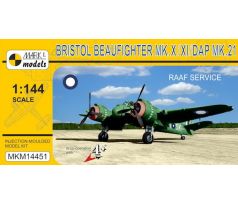
Bristol Beaufighter Mk.X/Mk.XI/Mk.21 'RAAF Service'
This injection-moulded kit contains 47 parts, 5 resin parts and six clear parts (cockpit canopies, position lights etc.). A comprehensive instruction leaflet and a decal sheet are included.
Colour schemes included in the kit:
1) Bristol Beaufighter Mk.X, A19-181 (ex-LZ322), White EH-Q, No.31 Sq., RAAF, Darwin airfield, Northern Territory, autumn 1944
2) Bristol Beaufighter Mk.XIC, A19-142 (ex-JM177), White J, No.30 Sq., RAAF, Vivigani airfield, Goodenough Island, Papua New Guinea, autumn 1943
3) DAP Beaufighter Mk.21, A8-124, White SK-T, No.93 Sq., RAAF, Labuan airfield, North Borneo, summer 1945
4) DAP Beaufighter Mk.21, A8-229, No.8 Communication Unit, RAAF, Madang airfield, Papua New Guinea, summer 1945
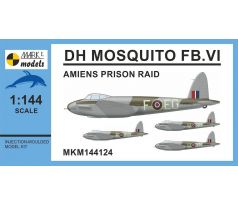
Mosquito FB.VI 'Amiens Prison Raid'
Colour schemes included in the kit:
1) de Havilland DH.98 Mosquito FB Mk.VI (Srs.II), HX922, Sky EG-F, No.487 Sq., Operation 'Ramrod 564", flown by Gp Capt P.C. Pickard & Flt Lt J. Broadley, Royal New Zealand Air Force, Hunsdon airfield, Hertfordshire, 18 February 1944
2) de Havilland DH.98 Mosquito FB Mk.VI (Srs.II), LR333, Sky EG-R, No.487 Sq., Operation 'Ramrod 564", flown by W/C I.S. Smith & Flt Lt P.E. Barns, Royal New Zealand Air Force, Hunsdon airfield, Hertfordshire, 18 February 1944
3) de Havilland DH.98 Mosquito FB Mk.VI (Srs.II), MM410, Sky SB-U, No.464 Sq., Operation 'Ramrod 564", flown by F/O K.L. Monaghan & F/O A.W. Dean, Royal Australian Air Force, Hunsdon airfield, Hertfordshire, 18 February 1944
4) de Havilland DH.98 Mosquito FB Mk.VI (Srs.II), LR403, Sky YH-U, No.21 Sq., Operation 'Ramrod 564", flown by Wg Cdr I.G. Dale & F/O E. Gabites, Royal Air Force, Hunsdon airfield, Hertfordshire, 18 February 1944
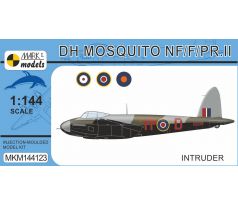
DH Mosquito NF/F/PR.II ‘Intruder’
Mark I Models 1:144
Colour schemes included in the kit:
1) de Havilland DH.98 Mosquito NF Mk.II, W4087, Red RS-B, No.157 Sq., Royal Air Force, Castle Camps airfield, Cambridgeshire, U.K., April 1942
2) de Havilland DH.98 Mosquito PR Mk.II, DD744, No.60 Sq., South African Air Force, Castel Benito airfield, Libya, North Africa, summer 1943
3) de Havilland DH.98 Mosquito F Mk.II, DZ228, Red YP-D, No.23 Sq., Royal Air Force, Luqa airfield, Malta, December 1942
4) de Havilland DH.98 Mosquito F Mk.II, DZ757, Red RA-Q, No.410 ‘Cougarʼ Sq., Royal Canadian Air Force, Coleby Grange airfield, Lincolnshire, U.K., September 1943
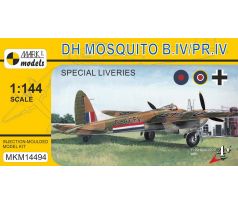
de Havilland Mosquito B.IV/PR.IV 'Special Liveries' (RAF, BOAC, Luftwaffe)
Description: This injection-moulded kit contains 64 parts and eleven clear parts (the cockpit canopy, nose window, wing tips with position lights etc.). A comprehensive decal sheet is included.
Colour schemes included in the kit:
1) de Havilland DH.98 Mosquito PR Mk.IV, DK310, Sky LY-G, No.1 PRU, Royal Air Force, Benson airfield, summer 1942
2) de Havilland DH.98 Mosquito PR Mk.IV, DZ473, No.540 Sq., Royal Air Force, Leuchars airfield, photographing Peenemunde with V-2 rockets, June 1943
3) de Havilland DH.98 Mosquito PR Mk.IV, G-AGFV (ex-DZ411), Black G-AGFV outlined in Light Grey, British Overseas Airways Corporation (BOAC), Leuchars airfield, used for high-speed diplomatic courier and "ball-bearing" flights between the UK and Sweden, early 1943
4) de Havilland DH.98 Mosquito B Mk.IV (Srs.II), Black T9+XB, 2./VVB OKL Trials and Research Unit of the Luftwaffe High Command (Versuchsverband des Oberkommandos der Luftwaffe), Luftwaffe, Konigsberg-Neumark airfield, Germany, summer 1944


